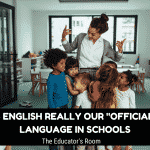My students are so diverse, and yet many with shared experiences. As a teacher, I soon learned to explore these diversities to find even more commonalities. The southeast Asian girl who wore the Hijab felt the same stares as the girl who demonstrated her own form of modesty by purposely not wearing makeup. The unnaturally tall White student felt the same exasperation as my Black student when people asked him daily if he played basketball. The Latinx female felt the same aggravation when people sat by her in Spanish as the Asian male who had students creep over to his desk in math.
How could I further explore what made them similar in so many ways while at the same time exploring and embracing the beautiful diversity that made them all so unique? This was yet another way to develop a purposely diverse curriculum. “How many of you live with both parents?” was my first question. A handful of hands shyly rose. “How many live with your dad?” Fewer hands… “How many live with your mom?” A few more hands…” How many live with another relative?” One or two hands soon became the majority of the room. Black, White, Asian, Latinx… this was a huge epiphany to my young and clearly naïve mind.
“You grew up with both of your parents?” The question one of my students asked me shocked me to my core! Jamal was unnaturally tall for a freshman, with his long, perfectly manicured dreads making his thin frame appear even smaller. I remember thinking, is he serious? “Yes.” Others looked surprised as well, but not at the question, but my answer. I debriefed with a fellow Black educator who didn’t understand my surprise. “The Black experience is in no way universal. You should know that.” Of course, I did, so why was I so shocked? Was it that it came from a Black kid? I had to do a quick mirror check.
We took this conversation even deeper. “What’s your ethnicity?” I asked a culturally ambiguous student I did not know very well. He looked around and began to mumble quietly. “He said hella stuff!” The class chuckled as Gina, my self-identified teacher’s pet, prodded him. “Tell her, Mo!” Mo had a full-grown beard and seemed so much older than the other freshmen. I would later find out that he was actually one of the youngest in the class. “Filipino, Dominican, Mexican, Aztec, and French.” His voice had a bass that further contradicted his age. The room got silent and then quickly buzzed with interested whispers. “What are you?” “Yeah, my mom said I got some Native American, but I don’t know what kind.” I sat back and watched silently as the engagement rippled throughout the class. Even Mo had occasional smirks as students who had seemed to ignore him in the past began to ask him questions.
Of course, I had to take advantage of this newfound class bonding and tie it back to my English lesson for the day. “Have you ever read any poets from your own cultures?” The White students looked confused, and my students of color had that “yeah right” look on their faces. “Mo, have you ever heard of Jose Garcia Villa?” Gina nearly always jumped into conversations. “Is he Mexican?” “Why do you say that, Gina?” “Well, his last name is Villa, right?” “Actually, he is Filipino.” Mo and other Filipino students in the class perked up. “We are going to find a poet from every ethnicity represented in this room!” The room again got silent, but the interesting whispers soon turned into a louder hum of anticipation. I leaned back even further into my chair and couldn’t hide the smile that seemed to emanate from my soul as the interest peaked to almost a dull roar.
As an English teacher, I knew we had to study poetry, and I knew we had certain literary and poetic devices we had to cover. I felt pride in how I was able to get them interested in Shakespeare’s Sonnet 130 once I made it relatable. I also felt accomplished in teaching many White, Asian, Latinx, Black poets, and writers. But this experience took my curriculum to another level. We studied poets from more diverse countries and cultures than I can name, and so many were new to me. I learned as they learned, and it was beautiful! To this day, I have alumni come and ask me if I still have the poster they did on their Cultural Poetry Project. They talk about how they felt validated, not only seen but that it was one of the few times in their education where they felt truly empowered in actually helping to shape their own learning.
Mo came to see me recently. He looked so different from the beard-clad “man child,” I remembered. Ironically, he is clean-shaven now. His voice was just as deep but much more confident. “I’m a teacher now,” he said. I felt tears well up in my eyes. We caught up on old times, life in and out of the classroom. I had always wondered what happened to him over the years. My smile got bigger and as he talked about how he, too, made sure to have at least one lesson that was student-driven and purposeful in its diversity. As he turned to leave, I found myself daydreaming about the many epiphanies I have had about the beauty of diversity in my career. Mo turned and said in his deep, soft, and shy voice I remembered, “Thank you.” I nodded and said just as softly, “Thank YOU, Mo, thank YOU.”




